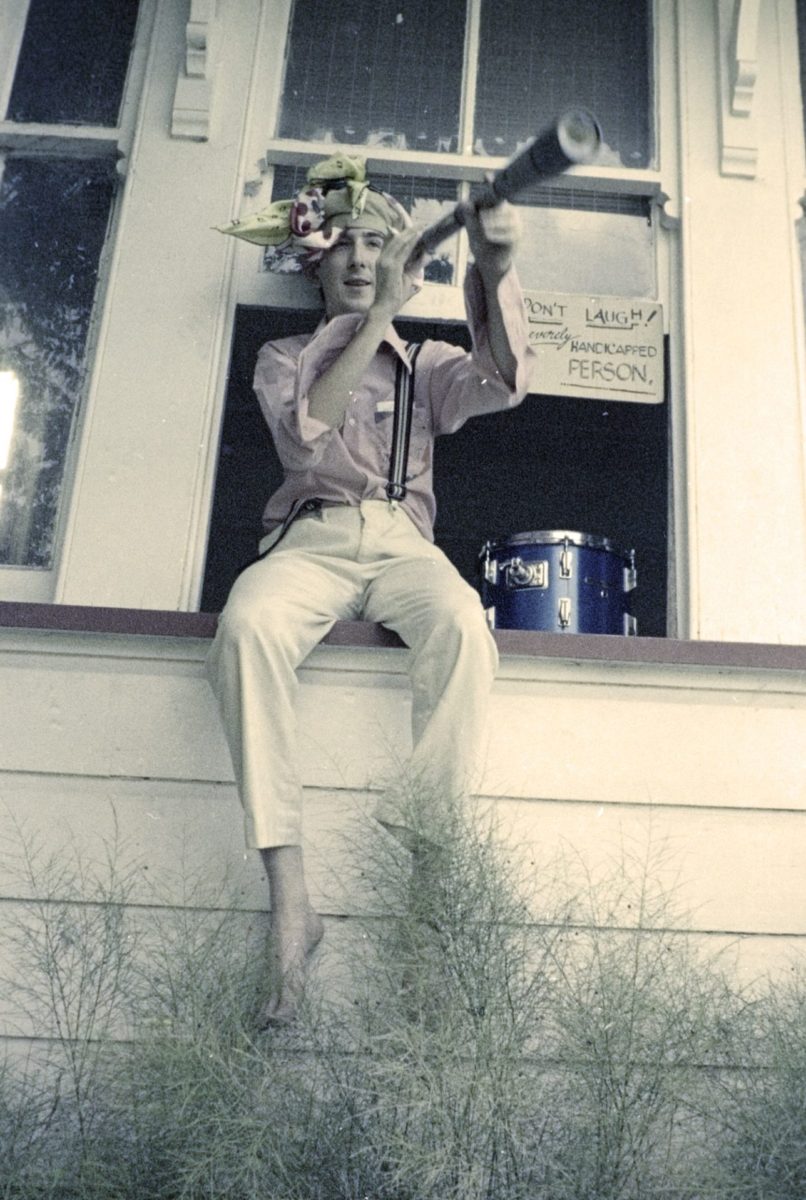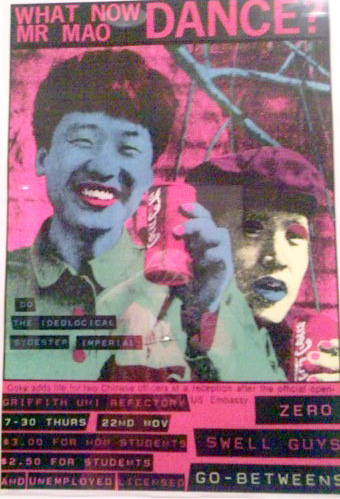“WHERE THE ACTION ISN’T, THAT’S WHERE IT IS”
By John Willsteed
Independence, a sense of adventure and a keen awareness that art-making had no boundaries – these qualities, lurking in the Brisbane underground music scene, struck me the moment I first joined Zero in 1978.
Zero had been around for a little while before I entered the maelstrom of Lindy, Iréna, Deborah and Nikki. If I’d had a hat, I would have held onto it. By the spring of 1980, it was just Iréna and me, and over the next few years we added and subtracted players like an abacus.
Pre-Zero, living in Kelvin Grove, I first met Ross Hinckley (aka Cecil) and Mark Titmarsh (aka Myles or Man Ray) and Lindy Lee (aka Lindy Lee) through Joan WIlmott, my outré landlady. I soon discovered the punk thing, and glided over to the Pink Palace, living with Tony Blake who was working at Activities. We made tacos for Freddo’s Vegaurant, playing hippy music to an audience of Chris Maver and probably a cat or something.
I moved into a share house in New Farm. Gary Warner lived there, and then Johnny Burnaway moved in. Michael Callaghan from Redback/Tin Sheds lived with us while he was out at Nathan – eye-opening posters. Gary introduced me to Lindy Morrison who drummed in Zero.
The Zero gigs were theatrical – both Lindy and later Clare McKenna (Xero drummer) had performance backgrounds in Grin & Tonic and the Popular Theatre Troupe – and brought theatre into “rock” spaces, as well as bringing rock into theatre spaces. These spaces were varied: bands and political theatre groups were bound together in lineups at public rallies, community halls and in traditional theatres. All just young people playing games. Games aplenty.
Gary’s Super8s were made inside our social situation and screening them at Zero and Xero shows created a tidy loop. Through Gary, I became friends with Terry Murphy, which led to Matt Mawson, Damien Ledwich, Allan Martin. Terry pulled me into poster printing and the connection with Activities at UQ was re-made. Adam Wolter was Gaz’s best mate and we were all involved in mail-art shenanigans and making little fanzines (Decay House Films Ink). Later, Adam Wolter like Davros, talking in mirrors, computing before anyone knew what the hell it was.
Iréna Luckus’ performance works at the gallery in Market Street and the old cathedral site above the crypt, on Ann Street in the Valley, were an introduction to the IMA and its denizens. Iréna and Valentina were friends with Martin and Hilary Boscott, Ted Riggs, Glenn O’Malley, Jenny Watson and John Nixon.
Our first warehouse rehearsal space was in the Valley. 1979. It was a hive, and we embedded ourselves in writing music and playing gigs, recording and filming, plotting and planning.
But once we were done with the Valley, moving into Red Comb house in late 1982 made good sense. We shared with equally creative, eccentric types. Earlier that year we had launched Zip Start, our group art/music project, at One Flat in Edmonstone Street. It was appropriate, then, to launch the second of the series, Zip Too, in October 1983, at the Art Bank in George Street – Jeanelle Hurst was, as always, a generous, amused and thoughtful host.
Zip was Terry Murphy, Matt Mawson, Irena Luckus, Tim Gruchy and me. We made little mags and music under our houses and crammed into sunrooms, releasing our first cassette magazine in 1982. ZIP was expressly created to play with the idea of the specialist. We were crossing boundaries of skill and expertise in order to create something new and unpredictable, with a strong desire to reach the widest audience.
The visual, the performative and the musical were being blended every day. The guitarist drawing and Letrasetting; the cartoonist toying with loops and machines; the graphic designer creating strange tunings on guitar; the sculptor shooting experimental videos.
It was a DIY world. We learned skills from one another, and made good use of the explosion of tool availability: cassette multitrack, colour phocopier, polaroid, photo-emulsion for screens. Like a Venn diagram, the disciplines expanded and the intersection became bigger and more diverse.
In December 1984, ZIP performed at the IMA as one of Three Nights of Performance, along with Sydney’s Climbing Frame and O’Flate, and we were included in the IMA Young Contemporaries show early in 1985 curated by Peter Cripps. Cripps had previously organized an ‘interdisciplinary experiment’ across a few Fridays in October – me, Erroll O’Neill, Sean Mee, blurry other folk. There were no public outcomes that I can recall.
Through these couple of years there were also: La Bambas at La Boite – vague memories of playing guitar while Michelle Andringa swung and Vik Gordon sang, and you too, Ginny Barratt?; performances and printing fabric at Belltower in the Valley; making noises for Ironing Boards at the BoomBoom; and of course, Xero was around for a bit. I was in the house band for Plastik at La Boite in 1983. There was music to be made with other theatre people too: Popular Theatre Troupe, Order By Numbers and UPU Theatre for the opening of the Performing Arts Centre. Mostly political in nature, but wasn’t everything?
December 1984 is remembered with great fondness: Brendan Smith, Terry Murphy, Antony Clare and I staged a VERY small exhibition at Le Scoops, a groovy ice-cream joint in Elizabeth Street. It seemed appropriate to return something to a space that had given us so much pleasure. 1985, Easter, I left for Sydney – following my heart.
Ross Harley’s Know Your Product, in 1986, was a really fine way to pull all this stuff together. Posters, vinyl, cassette, handbills and photos filled the IMA in Edward Street; gigs, screenings, radio concoctions on ZZZ, and a book to bind it. After all this time, it still shines. In this same year, I produced music and sound for Damien Ledwich’s animated short Feral Television. Our first proper trip into the film world was a collaborative triumph, and it pointed me towards AFTRS and a couple of decades in film sound.
It was a time of epic possibility – no boundaries on expression and no edges to the relationships. We drank of one another and feasted in the heat of the long nights. And as for The System? It didn’t even know we were there most of the time. Which was fine by me.
Title from Beasley Street by John Cooper Clarke, 1980
“WHERE THE ACTION ISN’T, THAT’S WHERE IT IS”
John Willsteed, 2016
Credits & Acknowledgments in order of appearance above (in progress).
Zero at UQ Relax Block, 1979. Photo by Paul O’Brien. Courtesy of State Library of Qld.
Zero big shits poster, 1979. A home job at New Farm by the look of it. Handcut stencil screenprint with Gilbey’s label. John Willsteed.
Live music at Freddo’s Vegaurant, St Lucia, Sept 1978. Photo by John Frame.
What Now Mr Mao, Screen Printed Poster, 22/11/79. Michael Callaghan, Griffith Artworks.
Clare and Ken Juggling – circa 1979. From Super8. Gary Warner
1979 Harcourt Backyard, New Farm. From Super8. Gary Warner
Decay House Films Logo – 1980. From Super8. Gary Warner
Harcourt Head, 1979 New Farm. From Super8. Gary Warner
Xero + GoBetweens, Ithaca Pool, 6/11/81. John Willsteed
Red Comb House Door, Photo: Peter Fischmann.
Red Comb House Mezzanine. 1982. Adam Boyd
Ink Lust Cover by Terry Murphy from Zip Start
Zip too, Inside pages, by John Willsteed.
Zip too, Luckus, Mawson, Murphy, Gruchy, Willsteed
Zip too exploded, Luckus, Mawson, Murphy, Gruchy, Willsteed
Le Scoops Show, 1984, Invite designed by John Willsteed
Know Your Product, Catalogue, Institute of Modern Art, 1986. Allan Martin
Willsteed with Telescope in New Farm, 1978. Gary Warner.
RELATED POSTS
RELATED ARCHIVES
Artist Profile
Related Archival Resources
No related posts.


















